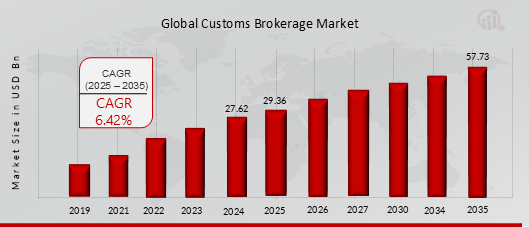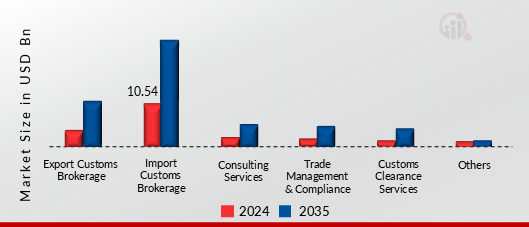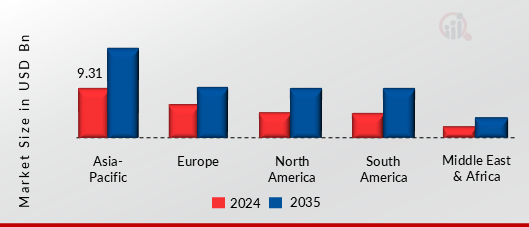Global Customs Brokerage Market Overview
The Customs Brokerage Market was valued at USD 27.62 billion in 2024. The Customs Brokerage Market industry is projected to grow from USD 29.36 billion in 2025 to USD 57.73 billion by 2035, exhibiting a compound annual growth rate (CAGR) of 6.42% during the forecast period (2025-2035).
The rising cross-border e-commerce driving customs clearance service demand and global trade agreements reducing barriers and boosting brokerage needs are driving the growth of the Customs Brokerage Market.
As per the Analyst at MRFR, Over the last decade, cross-border e-commerce has undergone explosive growth, fundamentally altering global trade dynamics. This growth is fueled by the increasing accessibility of the internet, mobile commerce, social media platforms, and digital payment systems. Consumers across the world are no longer limited to domestic choices; they can now order products from overseas with a few taps on their smartphones.
Major e-commerce platforms such as Amazon, Alibaba, eBay, Rakuten, and Shopee have aggressively expanded their international logistics networks, making it easier for both small and large merchants to reach global consumers. According to various market research firms, the global cross-border e-commerce market surpassed USD 800 billion in 2023 and is expected to reach well over USD 2 trillion by the end of the decade.
FIGURE 1: CUSTOMS BROKERAGE MARKET VALUE (2019-2035) USD BILLION

Source: Secondary Research, Primary Research, MRFR Database, and Analyst Review
Customs Brokerage Market Opportunity
DIGITALIZATION TRENDS ENHANCE EFFICIENCY IN CUSTOMS DOCUMENTATION PROCESSES
In recent years, the Customs Brokerage Market has experienced a transformational shift driven by digitalization. Traditionally, customs clearance processes involved manual paperwork, physical document submission, and time-consuming approvals, all of which created bottlenecks in international trade. However, with the rise of digital technologies, customs brokerage is becoming faster, more transparent, and significantly more efficient. Digitalization has brought notable improvements to documentation processes, which are at the heart of customs operations. These improvements are critical in reducing clearance delays, minimizing human error, and ensuring compliance with increasingly complex international trade regulations.
One of the key aspects of digitalization is the integration of electronic data interchange (EDI) systems, which allow for the seamless exchange of information between customs authorities, freight forwarders, and import/export businesses. EDI eliminates the need for repetitive data entry by automating the transmission of shipment details, tariff classifications, invoices, and other required documentation. This not only speeds up the clearance process but also reduces the likelihood of clerical errors that could otherwise lead to fines or shipment delays. For brokers, EDI offers the ability to track and manage numerous customs entries simultaneously, increasing both throughput and efficiency.
As more governments adopt electronic customs portals and Single Window systems, brokers who embrace these technologies can process high volumes of transactions with greater accuracy and in shorter timeframes.
Moreover, cloud-based customs software platforms are increasingly being deployed by brokerage firms and logistics service providers. These platforms offer real-time access to shipment data, compliance updates, and country-specific regulations, enabling brokers to make informed decisions quickly. Advanced platforms also incorporate features such as automated document generation, real-time alerts for non-compliance, digital archiving, and API integration with client ERP systems. This digital ecosystem not only improves internal workflows but also enhances client satisfaction by offering transparency and traceability across the entire clearance process.
For instance, a client can now receive automatic notifications when a shipment clears customs or when additional information is required, reducing downtime and uncertainty.
In addition to automation and cloud computing, emerging technologies like artificial intelligence (AI) and machine learning (ML) are adding further layers of intelligence to the customs documentation process. AI-powered platforms can analyze historical trade data, classify goods with greater accuracy, and flag potential compliance issues even before a shipment reaches the border. Machine learning algorithms continually improve over time, enabling brokers to better anticipate regulatory changes or identify discrepancies in customs declarations. These technologies also assist in managing large and complex datasets, such as multi-item shipments or consignments spread across multiple jurisdictions, thereby reducing human resource dependency and increasing scalability.
Digitalization also aligns with the broader push toward paperless trade, an initiative supported by international organizations like the World Trade Organization (WTO), the World Customs Organization (WCO), and the United Nations. These bodies have been advocating for the modernization of customs procedures through digital adoption, recognizing that paper-based systems are inefficient, prone to corruption, and environmentally unsustainable. Countries that have implemented digital customs systems report significantly improved border efficiency, reduced clearance times, and enhanced revenue collection.
For customs brokers, this shift represents an opportunity to reposition themselves as strategic partners in the supply chain, offering value-added digital solutions that go beyond basic clearance tasks.
Customs Brokerage Market Segment Insights
Customs Brokerage by Service Type Insights
Based on Service Type, this segment includes Import Customs Brokerage, Export Customs Brokerage, Consulting Services, Trade Management & Compliance, Customs Clearance Services, Others. The Import Customs Brokerage segment dominated the global market in 2024, while the Consulting Services segment is projected to be the fastest–growing segment during the forecast period. Import customs brokerage services primarily focus on assisting businesses in bringing goods across international borders into a specific country.
This involves navigating the complex regulatory environment related to import duties, taxes, product classification, valuation, and documentation. Brokers serve as intermediaries between importers and customs authorities, ensuring that all legal and procedural requirements are met before goods are cleared. These services reduce the risk of non-compliance and help companies avoid costly delays, penalties, or even confiscation of goods due to regulatory breaches.
FIGURE 2: CUSTOMS BROKERAGE MARKET SHARE BY SERVICE TYPE 2024 AND 2035 (USD BILLION)

Source: Secondary Research, Primary Research, MRFR Database and Analyst Review
Customs Brokerage by End-User Industry Insights
Based on End-User Industry, this segment includes Manufacturing, Retail & E-commerce, Automotive, Chemicals & Materials, Food & Beverage, Pharmaceuticals & Healthcare, Aerospace, Consumer Electronics, Others. The Manufacturing segment dominated the global market in 2024, while the Pharmaceuticals & Healthcare segment is projected to be the fastest–growing segment during the forecast period. The manufacturing sector represents a critical pillar of the Customs Brokerage Market, given its cross-border import and export requirements for raw materials, semi-finished, and finished goods.
As manufacturers increasingly adopt just-in-time production systems and rely on global supply chains, timely and efficient customs clearance becomes vital. Customs brokers in this segment help facilitate smooth trade flows, manage compliance with diverse regulatory requirements, and minimize delays at borders. They also play a crucial role in classifying goods, preparing documentation, and ensuring valuation accuracy to avoid penalties.
Customs Brokerage Regional Insights
Based on the Region, the global Customs Brokerage are segmented into North America, Europe, Asia-Pacific, South America and Middle East & Africa. The Asia Pacific dominated the global market in 2024, while it is projected to be the fastest–growing segment during the forecast period. Major demand factors driving the Asia Pacific market are the rising cross-border e-commerce driving customs clearance service demand and global trade agreements reducing barriers and boosting brokerage needs. The Asia Pacific customs brokerage market is fundamentally shaped by the region's diverse and often fragmented regulatory environment.
Each country in the region operates under its own customs framework, resulting in a lack of harmonization that complicates cross-border trade. For example, while ASEAN countries are making progress with the ASEAN Single Window, many of them still maintain individual import-export compliance protocols. Vietnam and Indonesia require multiple levels of documentation approval, often at the port level, whereas countries like Singapore have fully digitized systems that offer quicker clearances. These differences make it extremely difficult for exporters and importers to manage multi-country shipments without the help of regionally integrated customs brokerage services.
FIGURE 3: CUSTOMS BROKERAGE MARKET VALUE BY REGION 2024 AND 2035 (USD BILLION)

Source: Secondary Research, Primary Research, MRFR Database, and Analyst Review
Further, the countries considered in the scope of the Application Tracking System Market are the US, Canada, Germany, UK, France, Russia, Italy, Spain, Poland, Netherlands, Belgium, Luxembourg, China, India, Japan, South Korea, Malaysia, Thailand, Indonesia, Vietnam, Taiwan, Singapore, Brazil, Mexico, Argentina, GCC Countries, South Africa and others.
Global Customs Brokerage Key Market Players & Competitive Insights
Many global, regional, and local vendors characterize the Customs Brokerage Market. The market is highly competitive, with all the players competing to gain market share. Intense competition, rapid advances in technology, frequent changes in government policies, and environmental regulations are key factors that confront market growth. The vendors compete based on cost, product quality, reliability, and government regulations. Vendors must provide cost-efficient, high-quality products to survive and succeed in an intensely competitive market.
The major competitors in the market are FedEx Trade Networks, Inc., Nippon Express, DHL, A.P. Moller – Maersk, CEVA Logistics, United Parcel Service, Inc., DB Schenker, XPO Logistics, Agility Public Warehousing Company, Geodis S.A. are among others. The Customs Brokerage Market is a consolidated market due to increasing competition, acquisitions, mergers and other strategic market developments and decisions to improve operational effectiveness.
Key Companies in the Customs Brokerage Market include
- FedEx Trade Networks, Inc.
- Nippon Express
- DHL
- P. Moller – Maersk
- CEVA Logistics
- United Parcel Service, Inc.
- DB Schenker
- XPO Logistics
- Agility Public Warehousing Company
- Geodis S.A.
Customs Brokerage Market Industry Developments
July 2021: FedEx Logistics launched FedEx Trade Solutions, a new service within FedEx Trade Networks Transport & Brokerage, Inc. This service offers customized trade compliance solutions tailored to individual business needs. It aims to reduce complexity, time, and costs in global trade compliance by bundling services and providing single provider experience through FedEx Logistics.
February 2020: FedEx partnered with Freightos, a digital freight marketplace, to integrate FedEx Trade Networks' customs brokerage services onto the Freightos.com platform. This partnership enables more than 150,000 Freightos customers to access on-demand customs brokerage and freight forwarding services in one place, simplifying the shipping process and reducing intermediaries.
Customs Brokerage Market Segmentation
Customs Brokerage by Service Type Outlook
- Import Customs Brokerage
- Export Customs Brokerage
- Consulting Services
- Trade Management & Compliance
- Customs Clearance Services
- Others
Customs Brokerage by End-User Industry Outlook
- Manufacturing
- Retail & E-commerce
- Automotive
- Chemicals & Materials
- Food & Beverage
- Pharmaceuticals & Healthcare
- Aerospace
- Consumer Electronics
- Others
Customs Brokerage Regional Outlook
-
North America
-
Europe
- Germany
- UK
- France
- Russia
- Italy
- Spain
- Poland
- Netherlands
- Belgium
- Luxembourg
- Rest of Europe
-
Asia-Pacific
- China
- India
- Japan
- South Korea
- Malaysia
- Thailand
- Indonesia
- Vietnam
- Taiwan
- Singapore
- Rest of Asia Pacific
-
South America
- Brazil
- Mexico
- Argentina
- Rest of South America
-
Middle East & Africa
- GCC Countries
- South Africa
- Rest of Middle East & Africa
|
Report Attribute/Metric
|
Details
|
|
Market Size 2024
|
USD 27.62 Billion
|
|
Market Size 2025
|
USD 29.36 Billion
|
|
Market Size 2035
|
USD 57.73 Billion
|
|
Compound Annual Growth Rate (CAGR)
|
6.42% (2025-2035)
|
|
Base Year
|
2024
|
|
Forecast Period
|
2025-2035
|
|
Historical Data
|
2019-2023
|
|
Forecast Units
|
Value (USD Billion)
|
|
Report Coverage
|
Revenue Forecast, Competitive Landscape, Growth Factors, and Trends
|
|
Segments Covered
|
By Service Type, By End-User Industry
|
|
Geographies Covered
|
North America, Europe, Asia Pacific, South America, Middle East & Africa
|
|
Countries Covered
|
The US, Canada, Germany, UK, France, Russia, Italy, Spain, Poland, Netherlands, Belgium, Luxembourg, China, India, Japan, South Korea, Malaysia, Thailand, Indonesia, Vietnam, Taiwan, Singapore, Brazil, Mexico, Argentina, GCC Countries, South Africa
|
|
Key Companies Profiled
|
FedEx Trade Networks, Inc., Nippon Express, DHL, A.P. Moller – Maersk, CEVA Logistics, United Parcel Service, Inc., DB Schenker, XPO Logistics, Agility Public Warehousing Company, Geodis S.A.
|
|
Key Market Opportunities
|
· Digitalization trends enhance efficiency in customs documentation processes
· SMEs outsourcing logistics increases brokerage service utilization
|
|
Key Market Dynamics
|
· Rising cross-border e-commerce driving customs clearance service demand
· Global trade agreements reducing barriers and boosting brokerage needs
|
Frequently Asked Questions (FAQ):
USD 27.62 Billion is the Customs Brokerage Market in 2024
The Import Customs Brokerage segment by Service Type holds the largest market share and grows at a CAGR of 6.18 % during the forecast period.
Asia-Pacific holds the largest market share in the Customs Brokerage Market.
FedEx Trade Networks, Inc., Nippon Express, DHL, A.P. Moller – Maersk, CEVA Logistics, United Parcel Service, Inc., DB Schenker, XPO Logistics, Agility Public Warehousing Company, Geodis S.A. are prominent players in the Customs Brokerage Market.
The Manufacturing segment dominated the market in 2024.

















